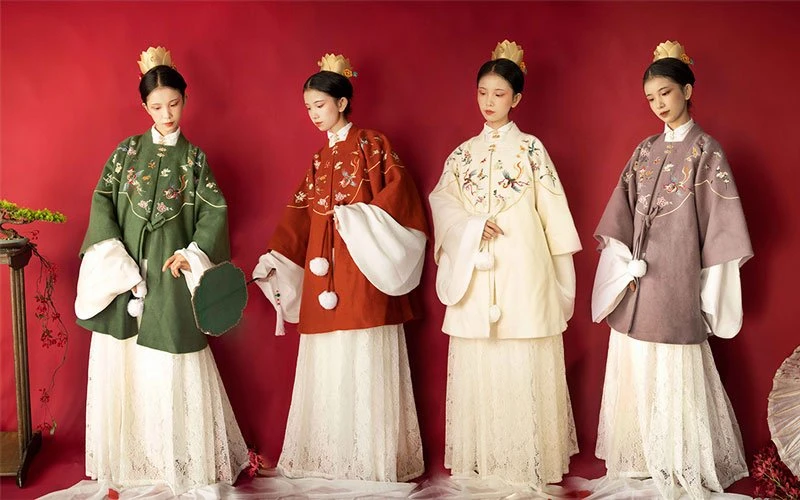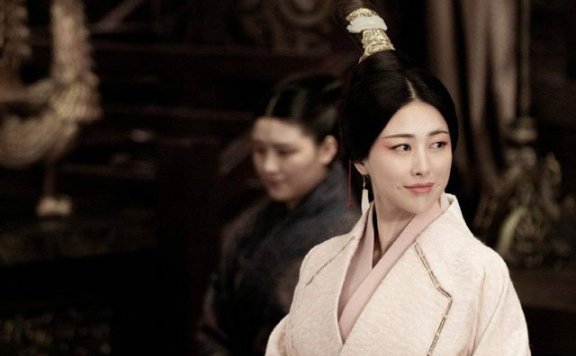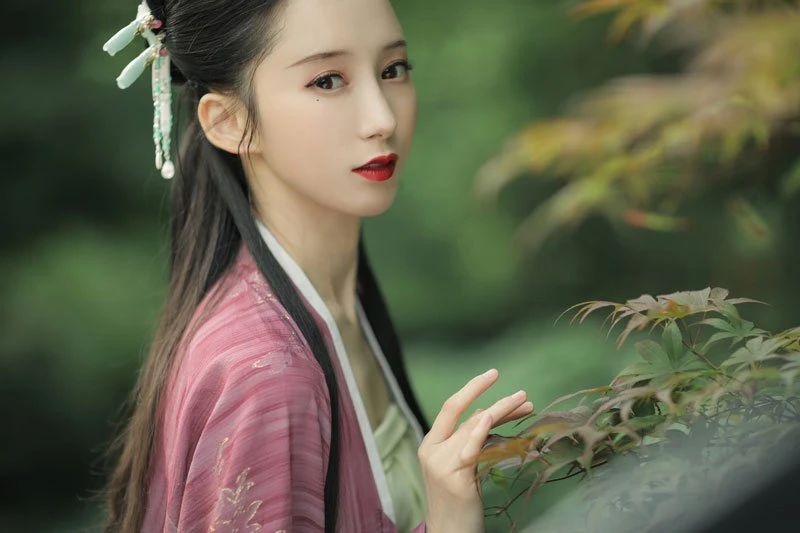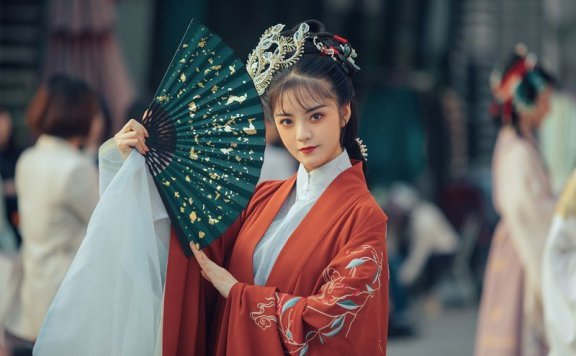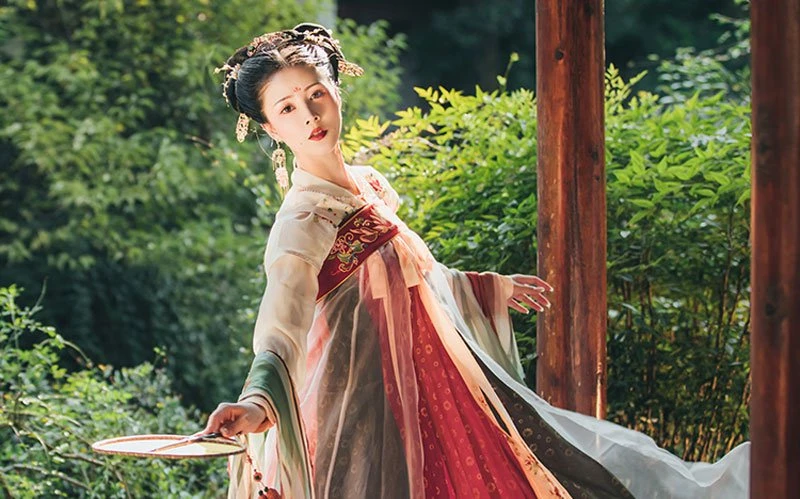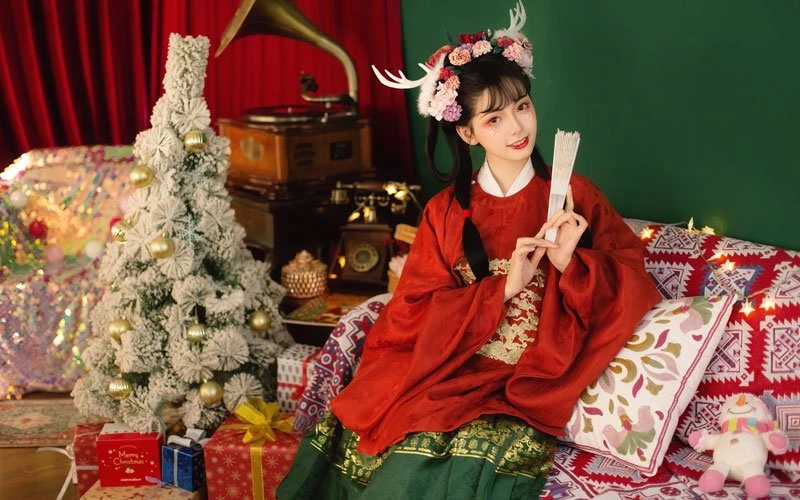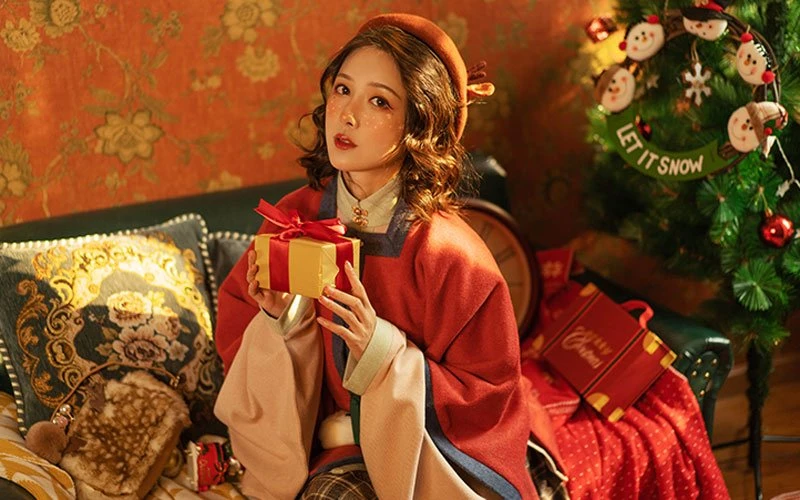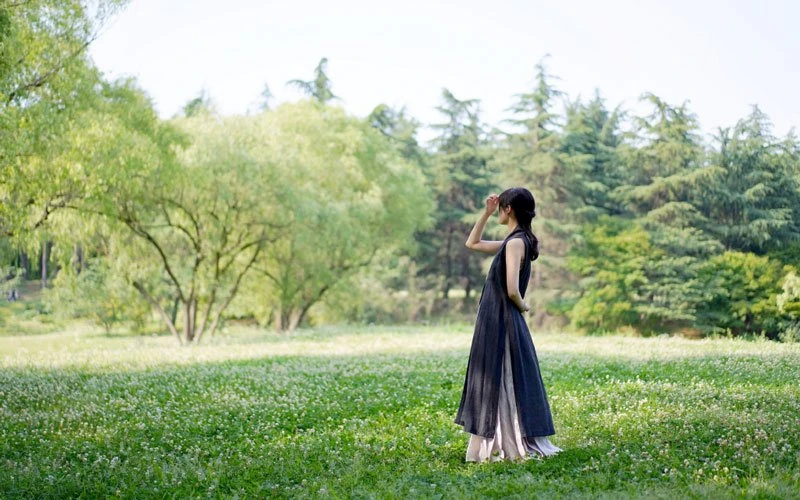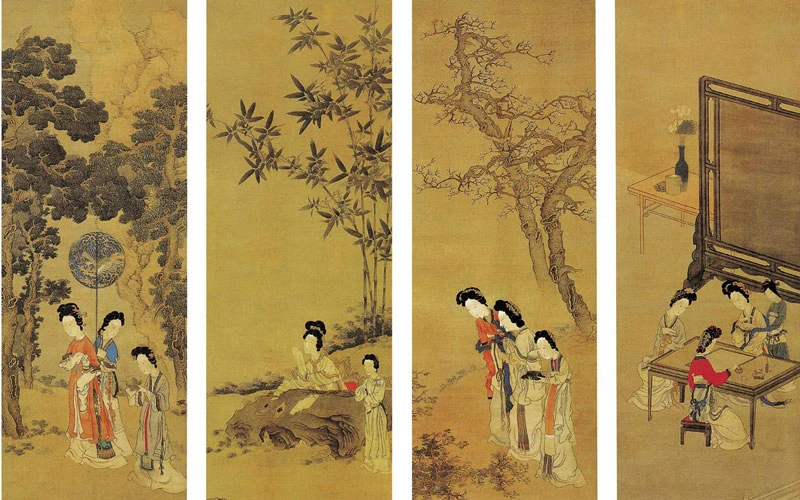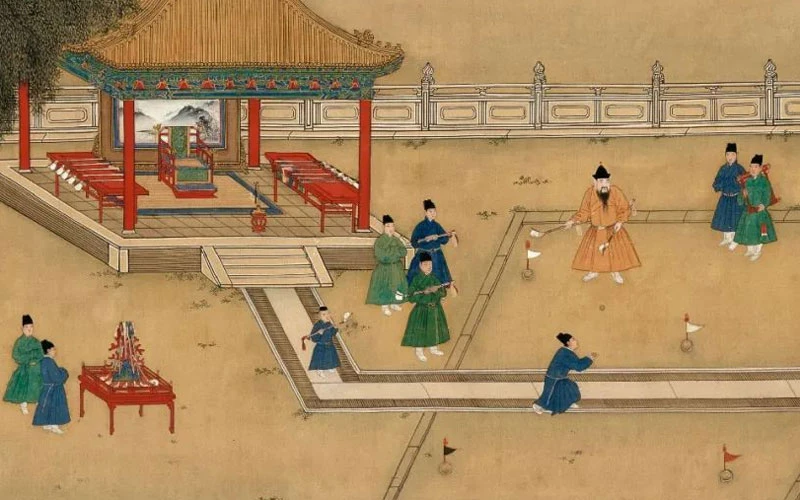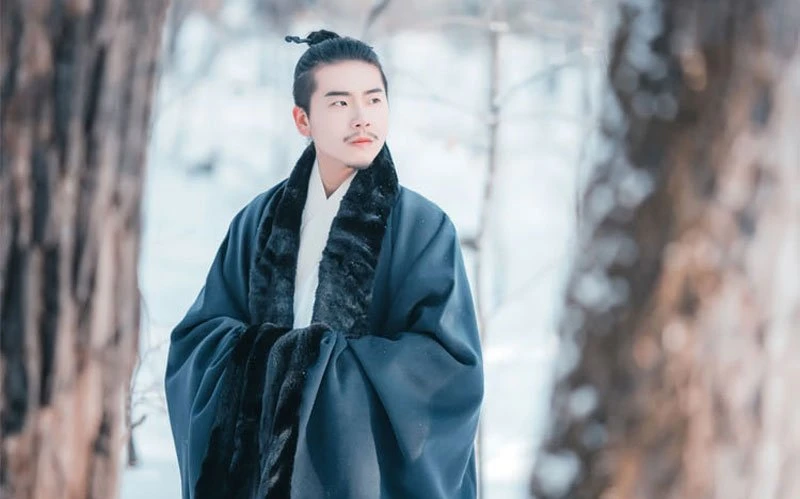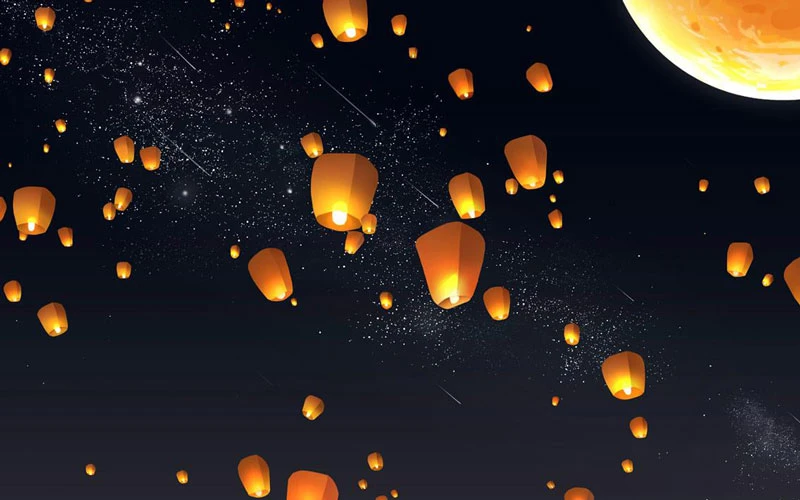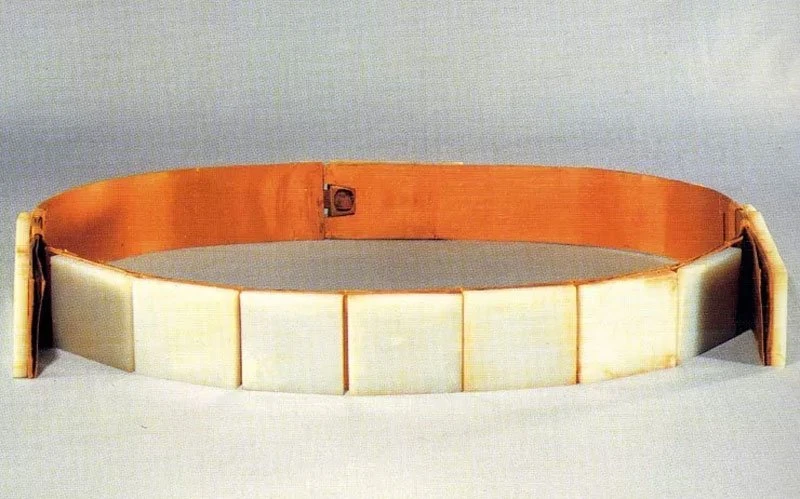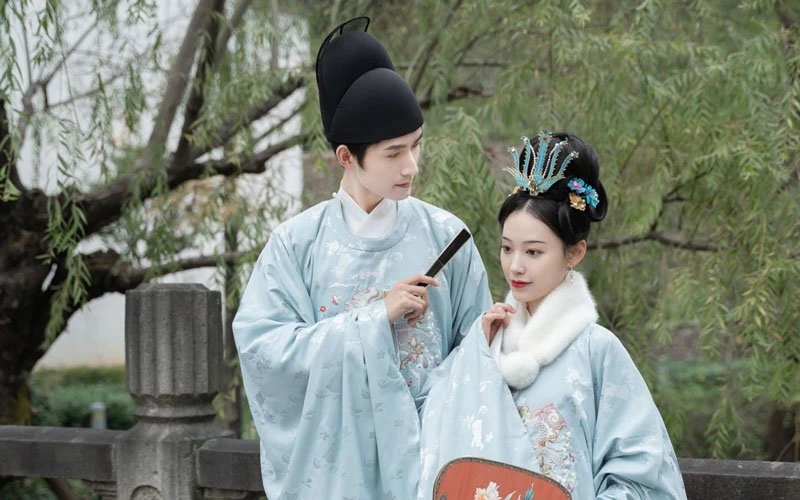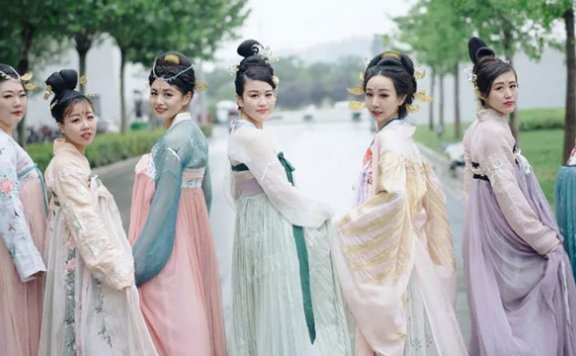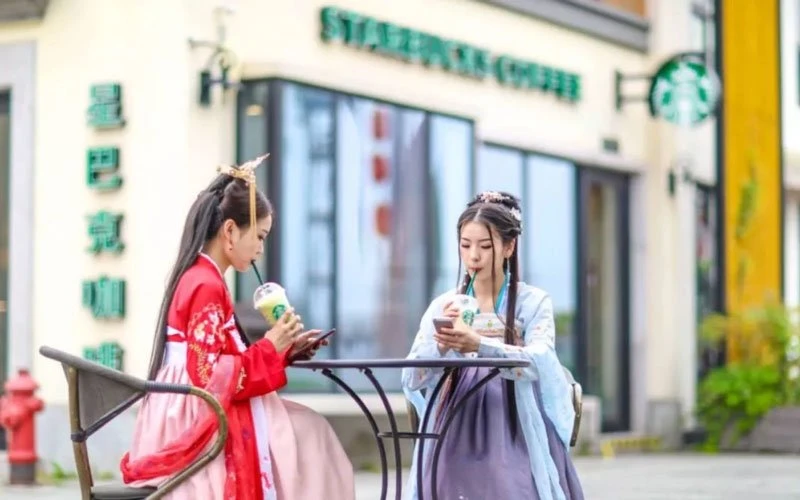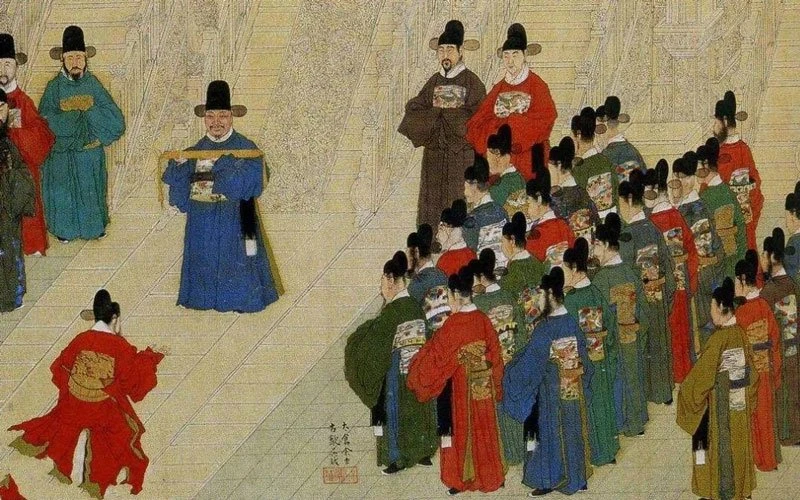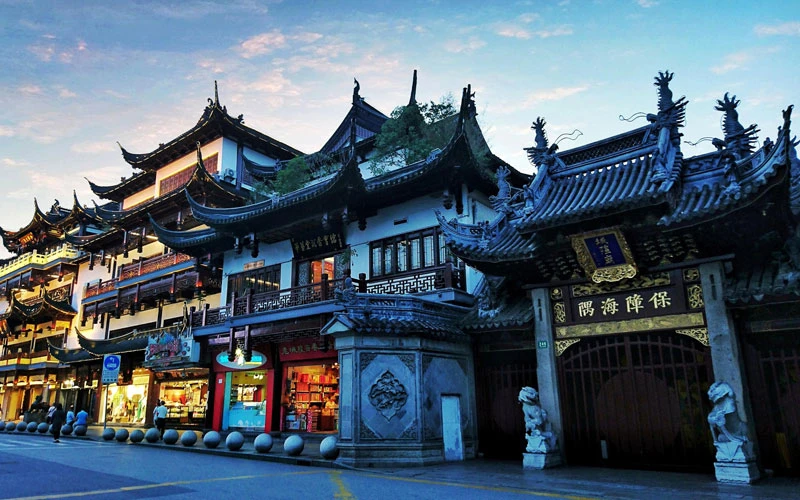Article
Search results for the keyword [ming]:
-
10 Traditional Chinese Colors & 4 Patterns Applied to Hanfu
The Colors of the Four Seasons | Chinese Dressing Aesthetics Color, is an important factor that constitutes the beauty of the art of dress. The ancients naturally did not ignore it. Classical Chinese dress colors originated from ancient times, as early as 18,000 years ago when the Beijing Cavemanused stone powder red to dye jewelry. For a long time, Chinese colors learned from the bright nature of birds' feathers, flowers, and so on, imitated the dyeing, and gradually became a system of its own, following the rules to use, expressing the transformation of seasons. Rites of Zhou has recorded: "For painting, the five colors are mixed. The symbol of the east is called cyan, the symbol of the south is called red, the symbol of the west is called white, the symbol of the north is called black, the symbol of the sky is called Xuan (dark black), and the symbol of the earth is called yellow." The center is also yellow. The colors of the Wuxing (五行, Five Elements) are yellow (earth, 土), white (metal, 金), cyan (wood, 木), red (fire, 火), black (water, 水), the colors of the four seasons are spring green, summer red, autumn white, winter… -
4 Exquisite Restore in Qin Dynasty Epic - Clothing & Makeup
Some time ago, the Ancient Chinese drama "Qin Dynasty Epic (大秦赋)" attracted a lot of attention. The drama tells the story of Qin Shi Huang Ying Zheng (秦始皇 嬴政), who with the support of ministers such as Lǚ Bu Wei (吕不韦), Li Si (李斯) and Wang Jian (王翦), in the late Warring States period, destroyed the six kingdoms, and established the first centralized state in Chinese history. The crew's skillful production of scenery and props and costumes, the details of which are highly restored to historical facts, bring a sense of "high class" rarely seen on the screen. Today we put aside the plot, to enjoy the "Qin Dynasty Epic" in the restoration of the ancient Qin dynasty costume and makeup look. About Military Costume Compared with the previous series, "Qin Dynasty Epic" has made a lot of efforts in costumes, props, and make-up, with more than 11,000 sets of costumes and 4,000 sets of armor for different characters, more than 80 chariots, siege chariots, and other large props, more than 10,000 pieces of swords, shields, spears and other weapons, more than 1,000 internal and external scenes and props, and many indoor appliances are modeled after archaeological objects, almost none… -
2021 latest updates on the Hanfu Movement
The Hanfu Movement has lasted for more than 10 years. Today hanfu is becoming popular, we could see more and more young people wearing hanfu clothes on the streets of China. Looking at the last decade, many people have mixed opinions about it. So let's take a look at the latest views on the Hanfu Movement in 2021. What is the Hanfu Movement? First of all, we should know that hanfu is the traditional costume of Chinese Han nationality. Since the Qing dynasty, it has been abolished for more than 300 years. With the development of China in the 21st century, the living conditions of the people have been continuously improved. The Han people realize that their traditional clothes should not be forgotten any more and began to revive the traditional Han clothing, this is the origin of the Hanfu movement. It's also part of the revival of traditional Chinese culture. We interviewed people from different regions and collected many opinions through online and offline, sort out these views listed as pros & cons, and neutral. And we also hope to hear your particular opinion on this topic. One should understand that when we discussing the national costume or clothing… -
Hanfu Girl: Siyue - Restore the Beauty of Four Classic Novels
Putting on the Chinese Hanfu costume, she is the king of the daughter kingdom in "Journey to the West (西游记)" and the sister of Baochai (宝钗) in "Dream of the Red Chamber (红楼梦)", with the classical charm flowing between her eyebrows and smiles, as if the characters from the Four Great Masterpieces (also includes: Romance of the Three Kingdoms (三国演义) and Water Margin (水浒传)) came to her eyes. The young Hanfu girl named Wu Chen (吴晨), who became popular online for a set of Hanfu photos. It is her interpretation of the beautiful women in the Four Great Masterpieces that has made many young people fall in love with Hanfu. In fact, she has a more special identity - the seventh generation inheritor of Changzhou Xiju (锡剧, also know as Wuxi Opera) Troupe. In Wu Chen's opinion, meeting Xiju and Hanfu are both wonderful encounters in life, and she also hopes to drive more young people to understand the traditional culture and inherit Chinese beauty through her creation. Accidentally Popular: Siyue Wu Chen was born in 2001, grew up in Jiangyin, Wuxi, and is now studying Xiju at the Jiangsu Drama School. She has long black hair with big watery… -
History of Peizhui - Most Exquisite Hanfu Ornament
When we introduced the Xiapei during the Song and Ming dynasties, we mentioned that the Xiapei hangs flat in front of the chest. The creation of Hanfu ornament: "Peizhui (帔坠)" is to ensure that the Xiapei (霞帔) is flattened in front of women's chest and belly when they move, maintaining a dignified image. Nowadays, you can often see girls who like Ming-style Hanfu hanging their Peizhui pendant around their neck for decoration. As an important part of Song and Ming women's costumes, the historical Peizhui pendant is integrated with the Xiapei, which serves the function of beautifying decoration and distinguishing social hierarchy. In the excavated tombs of Song, Yuan, and Ming dynasties, the silk fabric of Xiapei is not easy to be preserved, but the gold, silver, and jade quality of Peizhui has been preserved. Today, let's learn more about Peizhui pendant, a precious Hanfu ornament! Peizhui is usually made of two patterned curved pieces that are fastened together and attached to the end of the Xiapei in front of the body. The patterns are mostly hollow, often mistaken for scented sachet when unearthed earlier. The Peizhui unearthed in Song, Yuan, and Ming tombs are mainly made of gold, silver,… -
The 5 Most Popular Styles of Oriental Dress & Clothing - Asian Robe
What is the oriental dress, clothing? Due to the differences in history, culture, and geographical location, the traditional costumes of different countries in the world are not the same. Even in Asia, the oriental dress clothing of different countries is also colorful. On the continent of Asia, each country has its own unique and proud culture. Different states have different characteristics in their clothes, food, residence, and travel. And clothing is one of the things that can best record and show the cultural changes of a country. There are many kinds of traditional asian clothing, including Hanfu, Qipao, Kimono, Hanbok, Sari, Ao Dai, Chut Thai, Tajik clothing, etc. Today, let's learn about some of the most distinctive and representative traditional oriental dress, clothing. 1. Hanfu / Cheongsam China has a long history and its traditional costumes are constantly changing. From the upper and the lower garments system of the Yellow Emperor era, to the crown and uniform system of the Han Dynasty, to the Zhongshan costume of the Republic of China, it is a miniature of China's social environment in different periods. Hanfu: Hanfu is the general designation of "Han traditional costume", also known as Hanyiguan (汉衣冠), Hanzhuang (汉装),… -
5 Sets of Graceful Hanfu Photos for Christmas
Today we bring you Hanfu photos for Christmas, as well as a few tips. Choice of Hanfu for Christmas: The most recommended Hanfu is the Ming-style Hanfu, such as the standing collar Shan (立领衫), round collar Shan (圆领衫), square collar Ao (方领袄), Changshan (长衫), and Mamian skirt (马面裙), which are not only suitable for winter, but also for Christmas with the right color scheme. Of course, you can also mix and match other styles of Hanfu. Props of choice: make the most of the scenes and decorations you have around you and incorporate them into your photos as well! Christmas trees, dolls, or snowflakes. Use lights to create a warm atmosphere. Choice of accessories: Beautiful Christmas style accessories are also essential and a great addition. - Shanshuijing (山水镜) - Sishi (四时) - Miaozhu (喵竹) - Momiaomo (莫淼貘) Put on your Hanfu and leave your Christmas memories with your camera. -
4 Sets Hanfu for Christmas That'll Make You Special
When many people think of Hanfu, it must be the traditional clothing with long sleeves and fluttering skirts. Although different people have different impressions of Hanfu, there is a common understanding that it must have strong Chinese elements. But in fact, there are also Hanfu styles that go well with more fashionable elements in addition to the traditional format. As Christmas is coming up this year, let's take a look at what a Hanfu for Christmas style looks like. Square Collar Pi Ao + Standing Collar Ao + Pleated Skirt As we all know, autumn and winter are the most suitable seasons for Ming-style Hanfu, because most of them are very warm. The first set's top is a traditional Ming-style short Ao (袄) with standing collar and parallel opening, which is fresh and elegant, but it is not very "Christmas style" and warm, so it can be paired with a square collar half-sleeved Pi Ao (披袄) to ward off the cold wind and look more demure and lovely. The bottom skirt is a pleated skirt with modern elements, which is dignified and mature. The addition of Christmas style will be in this mature into cute and playful, with a top… -
4 Style of Hanfu for Daily and Commuter - Mix & Match
As the popularity of Hanfu continues to grow, there are more and more voices saying "Let's integrate Hanfu into daily life", but Hanfu for daily wear is not an easy task for some Hanfu lovers, not only should they wear complete sets of Hanfu, but they also need to match the appropriate hairstyle, accessories, shoes, and bags, which is also the reason why many Hanfu lovers are not willing to wear Hanfu every day. But! Today, I would like to introduce to you a lovely lady who perfectly integrates Hanfu into her work life: Li Guoguo (@李蝈蝈要当红军咕唧). Miss Liguoguo has been in contact with Hanfu for many years, and often shares her Hanfu outfits on social media. She loves to go to exhibitions, loves handicrafts, and is obsessed with the beautiful patterns in ancient Hanfu clothes. Best of all, she is creative in mixing and matching Hanfu with fashion. In the video, she made of her Hanfu for daily and commuter style mixed and matched with modern fashion, showing four elegant and charming looks, each outfit is beautiful, with the distinctive charm of Hanfu, and the dapper charm of commuter wear. It turns out that a gorgeous Hanfu can also… -
History and Characteristics of Chinese Painting
Chinese painting is the art of brush and ink applied on Xuan (paper) or silk. The basic tools are those of calligraphy, which has influenced painting in both style and theory. Characteristics and Categories of Chinese Painting A distinctive basic characteristic of this painting is that ideas and motifs are presented primarily in the form of lines and dots in ink, rather than in color, proportion, and perspective. These works are conceived with the aid of brushes composed of handle and head. The handle is usually made of bamboo or wood, while the head is made of animal hair, usually sheep or wolf. The heads are soft and flexible, and suitably fit the style of Chinese painting. Usually, only black ink is used, and silk and thin paper are used for the "canvases". Chinese painting falls into three main categories: portraits, landscapes, and flowers and birds. Of the three traditions, the oldest is portraiture, dominating the scene until the late Tang dynasty. In general, landscape paintings depicted mountains and water, influenced by the Taoist tradition of seeking solitude in nature. Landscape dominated in the 11th century, becoming a favorite motif of artists. Even today, when a Chinese says a place… -
What Sports Were Played in Ancient China?
Chuiwan: ancient golf In ancient China there was another sport, in which a stick was used to hit a ball. At first there were two ways to play: on horseback or on foot. The first resembles polo, a sport as popular as cuju in the Tang Dynasty. The second is like field hockey today, a highly competitive contest calculated by the number of goals. In the Song dynasty, a new method, called Chuiwan (捶丸), was invented. There were two main differences between chuiwan and the previous game: first, the ball was not hit into the goal but into a hole; second, direct confrontation was changed to indirect confrontation. The game of chuiwan consisted of two teams hitting the ball with a stick into the holes previously dug in the ground. Those who hit the ball the least number of times to get it into the holes or those who had the most goals were the winners. Chuiwan can be played individually or as a team. The distance between the batter and the holes differed from 10 to 20 meters. When one hit the ball and got it into the chosen hole in three strokes, one won a point. The sticks… -
Traditional Chinese Winter Clothing for Male - Changyi
As you may know, the Ming-style Hanfu is perfect for the winter, because it's wide enough to fit a lot of warm clothes. So, what other Chinese winter clothing can you think of for winter wear besides the Ming-style? Maybe Changyi is a good choice, follow along with Hanfu Culture Society to learn more about this Hanfu style that will bring you warmth in the cold winter. [Structure and History] Changyi (氅衣, chǎng yī), also known as Hechang (鹤氅) or Dachang (大氅). Straight collar, parallel opening, large sleeves, a pair of laces on the front lapel to tie the knot, the length of the coat is up to the calf or ankle. The body is mostly light in color, but can be decorated with ornate patterns, with dark edges on the collar and sleeve edges, and usually with no slits on the sides, but can be made with slits or pleats. As one of the categories of traditional Chinese winter clothing for male, Changyi has appeared in traditional Chinese literature with high frequency since the Eastern Jin Dynasty. However, the actual form of the Changyi varies greatly from one period to another. The earliest recorded appearance of the Changyi as… -
Ingenious Inventions of Ancient China
Chinese inventions are great achievements for socio-economic development and scientific and technological progress, both in China and worldwide. But China also contributed other creations, not so outstanding, but no less ingenious, which have not lost their sense of usefulness with the passage of time. Today, let's witness the wisdom and intelligence of the Chinese. The Abacus The abacus evolved from the token calculus in Cheng Dawei, Ingenious Inventions of Ancient China. About 2,000 years ago, Chinese ancestors mastered simple calculation with counters. In the Spring and Autumn period, mathematical calculations were made using tokens of various colors and values. However, with the socio-economic progress of mankind, this type of calculator no longer met the growing demand. Thus the abacus was born. The principles for the use of this device are similar to the calculation with counters, but are more advanced, faster and easier than the former. The term for the use of the abacus is called in Chinese "Zhu Suan" (Bead Calculation). Its earliest historical record is in the book "Shushu Jiyi" (Documents on Mathematics), created by Xu Yue (?-220), a mathematician of the Eastern Han dynasty in the EL century. In the drawing "Qingming Shanghe Tu" (Scenes by… -
The Most Classic Hanfu of All Time
In the process of evolution, there are dozens or even hundreds of styles of Chinese clothes. This article mainly introduces the most classical styles of Chinese Hanfu clothes. Women's clothing Suit Ruqun(襦裙) Ruqun is a kind of hanfu, also call: Shanqun (衫裙), short clothes worn on the upper body, call "Ru", and the dress of the lower body, call "Qun", together call "Ruqun". It is a typical "Shangyi Xiachang(top clothes and underdress) " form. Ruqun has an obvious feature: short top and long dress. The Ruqun appeared in the Warring States Period, Ruqun was worn by ordinary people(female) until the end of the Ming and Qing Dynasties. Jiaoling Ruqun/ Shanqun(交领襦裙/衫裙) Jiaoling Ruqun is a kind of Ruqun, the main feature is: the top collar is cross. It is quite common in the Song Dynasty. Wearing method: First: Wear top clothes, Align the collar of the top clothes; Tie a knot in right Jin(襟, the chest part of the top); Tie a knot in left Jin. Second: tie up the dress, Put the dress in front of you, wrap the skirt behind you; Two sides of the dress overlap behind; Folding outwards the pressing on the inner layer of dress;… -
History of Hanfu Sash & Belt Ornament in Ancient China
In the ancient Chinese costume system, Hanfu sash and belt ornaments played a very important role, not only as a means of securing and decorating the garment, but also as a symbol of the wearer's status. In ancient times, officials wore Chaofu (朝服) when going to Shangchao (上朝). The Chaofu was the ancient official's uniform for political discussions, one of the important functions of Chaofu in ancient China was to distinguish between the ranks of superior and inferior through clothing. This distinction was mainly made through the three aspects of the Guan (冠, headwear), the color/Zhangwen (章纹) of the garment, and the belt ornaments. The belt ornaments on Chaofu, specifically the belt and the various types of pendant hanging from it, are mainly of the following types: jade pendants, Bixi (蔽膝), Yinshou (印绶), and Yufu/Yudai (鱼符/鱼袋). In ancient Chinese Chaofu, belt ornaments were a very important part, especially for men, as they were almost the only ornaments they wore and were important identity markers. The role of the belt ornament in expressing the wearer's rank was clearly and straightforwardly defined in the costume system during the Zhou dynasty, and was later enriched and refined through the ages. Hanfu Belt for… -
What is Chinese Headdress - Hanfu Traditional Hats Introduce
A complete set of Hanfu includes Shoufu (首服, hanfu headdress), Tiyi (体衣, hanfu clothes), Zuyi (足衣, hanfu shoes and socks) and accessories. Let's talk about the Chinese headdress today. Chinese headdress brief introduction The Chinese headdress is one of the important parts of ancient Chinese clothing, In ancient times, both men and women of Han nationality coiled their hair into a bun and fixed it on their heads with a hairpin. The main Chinese headdress is Guan (冠, crown, a hat that goes with a formal dress in ancient), Mao (帽, hats), Jin(巾, kerchief), etc. Mao mainly includes gauze hat (纱帽), hood (风帽)and Jin mainly has the black silk ribbon scarf (纶巾), the net kerchief (网巾) and so on. When the Yellow Emperor invented the Guan, the rite of adulthood of the Han nationality - the rite of male Guanli (冠礼) and the rite of female Jili (笄礼) - shows that Shoufu plays an important role in the national cultural psychology. Since the Qin Dynasty, there has been no separation of Yi and Guan (clothes and hats). However, due to the feudal concept, the number of women in the civilian class wearing the Guan is very small. Many years later, in… -
Top 5 Styles of Traditional Chinese Dress & Clothing
The story of clothing and costumes is one of the most fascinating developments in human history. Traditional Chinese Dress & Clothing has a long history and cultural content, and it is an important part of Chinese excellent cultural heritage, so It has particular researching value. https://www.youtube.com/watch?v=YaD4vS2GQxw Every nation in the world has its unique traditional clothing. The particular histories and cultures could be recognized so as for people to distinguish one citizen from another. China, as a multi-ethnic and time-honored country, has many ethnic minorities who have their indigenous culture. The mutual influences among these different cultures have contributed to the rich textures and fabrics of history and have made Chinese clothing with great variation and glory. Traditional Chinese dress & clothing has been shaped and developed alongside the interactive influences between the outside world and China’s own dynastic traditions. Every different dynastic has different scopes of territory, social values, social norms, etc. Therefore, many aesthetic standards were made according to the environments (socially, geographically, economically, politically) of certain dynastic. This is the main reason why traditional Chinese clothing has such many styles. 5 Types of Traditional Chinese Clothing & Dress For exploring the world of traditional Chinese clothing, it is necessary… -
What is Hanfu? What does it Stand for?
What is Hanfu? At present, the full name is widely recognized as the “traditional costume of the Han nationality”, that is, the clothes worn by the Han nationality from the Yellow Emperor’s accession to the throne to the late Ming and early Qing Dynasty. On September 30, 2019, a group of young people in Chinese costumes Hanfu came to the streets of Sydney Opera House with zither and pipa. They sang "my country and me" with music in foreign countries. According to @Ms. Tingyue, the initiator of the event, this is a Hanfu flash event in three landmarks in Sydney, aiming to promote traditional Chinese culture. What is Hanfu? At present, the full name is widely recognized as the "traditional costume of the Han nationality", that is, the clothes worn by the Han nationality from the Yellow Emperor's accession to the throne to the late Ming and early Qing Dynasty. On the Internet, the most popular styles are Qiyao-Ruqun (齐腰襦裙) in the Wei and Jin Dynasties, Qixiong-Ruqun (齐胸襦裙) and large sleeved shirt (大袖衫) in the Tang Dynasty, as well as Beizi (褙子) in the Song Dynasty and Horse-face Dress (马面裙) in the Ming Dynasty. The earliest appearance of Hanfu was… -
The Development of Chaofu in Ancient China
We often see in Chinese TV dramas or movies scenes of the emperor and his ministers discussing political affairs together (called Shangchao, 上朝), with the ministers standing or kneeling opposite the emperor in order of rank, dressed in tidy clothes (Chaofu). So, what is so special about the ministers' clothing? And are the different eras of Chaofu the same? What is the Chaofu? Name: Chaofu (朝服, cháo fú) Alias: Jufu (具服) Function: used at major ceremonies Succession and change: from Zhou to Ming dynasties Before the Zhou Dynasty, Chinese clothing was mainly made in one form, the upper Yi (衣) and the lower Chang (裳) system. The Book of Rites - Yuzao (礼记·玉藻, a chapter describing the ritual) recorded that "Chao Xuanduan (玄端), Xi Shenyi (深衣)", meaning that ministers were required to wear Xuanduan in the morning to attend the Shangchao, while worn Shenyi at home in the evening. The style and development of Chaofu in different dynasties The earliest Chaofu - Pibian Fu Judging from the literature, there were Chaofu as early as in the Zhou Dynasty. The first Chaofu was the Pibian Fu (皮弁服, pí biàn fú), which was made of fine white cloth, and the Yi and… -
THESE ANCIENT CITIES IN CHINA WILL TAKE YOUR BREATH AWAY
Chinese culture is one of the oldest in the world. That is why the country has many ancient cities, which are well preserved and have become places really worth seeing. Since time immemorial, China has been considered a "Celestial Empire" where divine and mortal beings live together. And Chinese culture is the only culture in the world that has a continuous recorded history of over 5,000 years. Accordingly, even today there are countless ancient cities, some of which are really very well preserved. These historical sites are now some of the most fascinating and must-see attractions in the entire country. Which of these great cities you definitely have to see once in your life, we tell you here. Daxu The small town of Daxu has located 20 km from Guilin on the Li River. Its history goes back over 2,000 years. It was once the terminus of the southern Silk Roads and flourished in the Middle Ages due to trade. Today you can still admire traditional Chinese architecture. Beautiful stone streets, marketplaces, and bridges, as well as ancient buildings that are incredibly well preserved. Pingyao The old city of Pingyao has around 40,000 inhabitants and a 2,700 year old history.…
